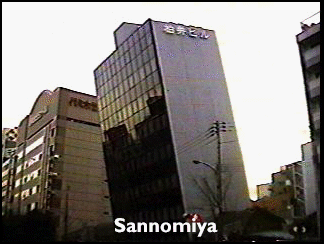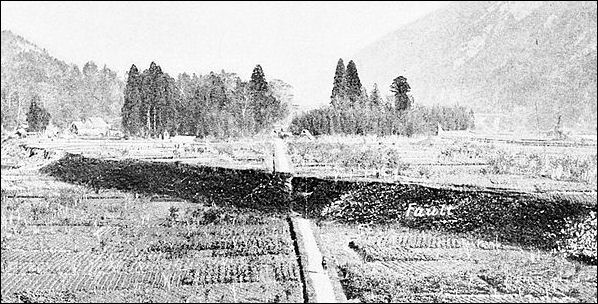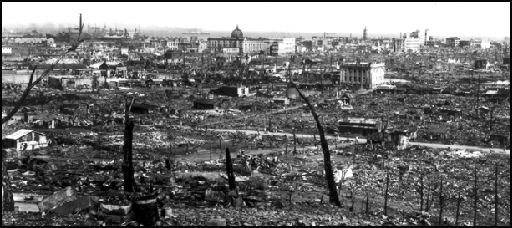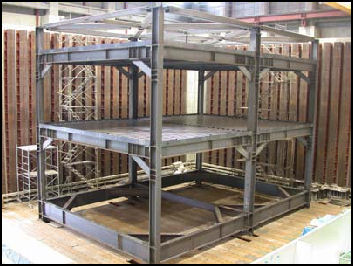EARTHQUAKE DAMAGE

Damage from the 1995 Kobe earthquake in Japan Earthquakes with a magnitude of more than 7 on the Richter scale strike 20 times a year somewhere in the world. But these are not necessarily the most destructive earthquakes. The biggest factor in determining earthquake damage and destruction is location, location and location. Earthquakes that strike populated area are going to cause more death and destruction than ones that occur in unpopulated areas.
Some of the most damaging and deadly earthquakes — the one that killed 250,000 people in Tangshen China and the ones in Lisbon and Missouri — occurred is places where no one though a major earthquake would happen and the victims were caught totally unprepared.
Earthquake damage is also often more of a matter of architecture and affluence than the strength of the earthquake. In developing countries the houses are often shoddily built. In the worst case they are made of stones held together with weak mortar and topple easy, crushing people when they do. That is why a 6.0 earthquake in Armenia could kill 26,000 people and a 7.1 one in San Francisco could kill 62.
The damage from an earthquake is often very spotty. Neighborhoods that have been totally destroyed often six next to ones that look untouched. The reason depends on a number of factors including construction methods, maintenance, soil stability, fault lines in the underlying rock, and location of gas lines.
Some deaths are attributed directly to the earthquake. Many more often die in mudslides, landslides, and tsunamis generated by the quake or in the harsh conditions that follow it. Landslides block roads, leaving thousands with food and shelter. Disease spread; no medical help is available.
Fires often cause the most damage. Sometimes the fires are so hot the can melt steel and ignite fires 40 meters away. Many start when stoves topple over or gas lines break. Often the fires burn out of control because water main are broken and not enough people can be mobilized to put them out.
See Separate Articles EARTHQUAKES: GEOLOGY, FREQUENCY, TYPES, ENERGY AND RESEARCH factsanddetails.com ; CAUSES AND PREDICTIONS OF EARTHQUAKES factsanddetails.com ; EARTHQUAKE SAFETY AND SURVIVAL factsanddetails.com TSUNAMIS: CAUSES, PHYSICS AND DANGERS factsanddetails.com
Good Websites and Sources: U.S. Geological Survey (USGS) National Earthquake Information Center earthquake.usgs.gov ; Wikipedia article on Earthquakes Wikipedia ; Earthquake severity pubs.usgs.gov ; Collection of Images from Historic Earthquakes Pacific Earthquake Engineering Research Center, Jan Kozak Collection ; World Earthquake Map iris.edu/seismon Most Recent Earthquakes earthquake.usgs.gov ; Earthquake Pamphlet pubs.usgs.gov ; USGS Earthquakes for Kids earthquake.usgs.gov/learn/kids ; Earthquake Preparedness and Safety Surviving an Earthquake edu4hazards.org ; Earthquake Preparedness Guide earthquakepreparednessguide.com ; Earthquake Safety Site earthquakecountry.info
Earthquake Liquefaction

leaning building at Kobe in 1995 due
to liquification of soil Liquefaction is a phenomenon where pockets of stable sand underground are shaken by an earthquake and mixed with groundwater. As a result, the soil becomes sludgy and unstable. In some cases, muddy water reaches the surface. Because the ground foundation suddenly becomes soft, buildings may sink or tilt. Tilted houses, rippled pavement, broken pipes are all problems associated with liquefaction. [Source: Akio Oikawa and Shogo Hara, Yomiuri Shimbun , October 18, 2012]
Liquefaction pushes up manholes and wrecking homes and roads and leaves houses and power poles tilting. Watery sand can gush up from the ground during the earthquake formed piles up to 30 centimeters deep. Ground subsidence of up to 50 centimeters, which destroyed underground water and sewerage pipes. If the shaking from an earthquake continues for a long time, the ground where the liquefaction is most severe can keep shaking even after liquefaction occurrs, expanding the scope of damage.
Liquefaction occurs when saturated sandy ground, such as that found in reclaimed land and marshes, is loosened by a strong earthquake. The unconsolidated sand becomes like muddy water. This muddy water gushes up through cracks and opening in sidewalks and roads, and then drains away to leave the sand on the ground. Foundations can be fixed by jacking up a house and doing the repairs. But with the lingering threat of aftershocks, the land could be vulnerable to more damage. Leaving a house as it is, however, could leave it beyond salvaging if liquefaction strikes again.
Earthquake Damage and Buildings
About 80 percent of all earthquake deaths occur in collapsed building. Many of these would have been avoided if the buildings were properly constructed. One geophysicist told the New York Times, "Buildings kill people not earthquakes."
Structures built on rock suffer high-frequency vibrations that may not topple the building but can cause enough structural faults to make it unsafe. Buildings on softer soils need special braces because the building can resonate with the quake and vibrate part.Buildings on reclaimed land or soil saturated with water are particularly vulnerable because the soil can liquify and shake extremely violently, causing entire building to lean, sink or topple.
Unreinforced buildings sway from side to side and if the earthquake is powerful enough give way and collapse. The joints where H-shaped steel beams are welded to the main pillars are typically the most vulnerable spots of a building. Seismic energy converges on the joints which can crack under the force.
Old wooden houses are shaken off their foundations, causing roofing and unsecured items to topple on residents. High rises are designed to sway. They often remain standing and keep their occupants alive but suffer from broken windows and cracked girders and sometimes have to be torn down.
Mid-rise buildings — especially ones with unreinforced masonry are often the most dangerous places to be. Their rigid walls tend to crack and crumble rather than sway. After a large earthquake many of the welded joints give way under the stress and the building tilts, and sometimes collapse, sometimes killing most of the people inside.
People trapped inside collapsed buildings without food and water or adequate supplies rarely survive under the rubble for more than three or four days. Without water, especially in the summer heat, people are claimed by dehydration. After earthquakes villagers sometimes spend months sleeping in their beds outdoors until the threat passes.

Visible uplift along the fault that caused the great earthquake in central japan in 1891
Earthquake Damage and Infrastructure
Unprotected electric power lines, waiter mains and gas lines rupture, causing power outages, fires and flooding. Roads and bridges give way as a result of the shaking and swaying. Damage not only causes immediate deaths and casualties but hampers rescue efforts, causing more deaths.
Land line communications are disrupted hampering rescue efforts even more. Hospitals with structural damage and power outages have a hard time maintain a normal functioning level, let alone keeping up with the high numbers of casualties that pour in.
In large cities, subways and trains can become derailed; tunnels and stations can crack, collapse or become flooded. Tunnels are particularly vulnerable where one ground material change into another such as between rock and soil. Damages can be catastrophic if an oil refinery or chemical factory near a populated area explodes or catch fire. Even worse is if a levee system or a dam upstream from a populated area collapses. Another big hassle is a shortage of toilets.
Earthquake Damage and Buildings in the Developing World
Many victims of earthquakes in the developing world die because they were caught inside poor housing. Masonry structures with mud brick or concrete blocks walls and clay tile roofs are regarded as death traps. Common on the developing world, they are not built to sway or move in an earth quake and often have floors added in a piecemeal fashion. Even an earthquake of moderate strength is enough to break the brittle walls and supports. The materials are bulky and have trouble absorbing shock and can kill because the materials are so heavy.
Many buildings are little more than unreinforced masonry piles. Stone walls and concrete roofs are a particularly nasty combination. In an earthquake, the stones crumble, the walls give way and the heavy concrete roof collapses, causing serious injury or death to anyone caught underneath.
Mud brick houses are often the most deadly. Unlike houses made of concrete and wood that collapsed in jumbles and leave gaps for survivors, mud brick homes tend to crumble in piles. Many people died from being crushed; other suffocate from the weight of the brick on top of them, lack of air and breathing in dust. Mud bricks are a popular building material because they are cheap and warm in the winter and cool in the summer.
Apartments with little or no steel in the concrete pillars are among the deadliest structure of all. Under the heavy weight, the floors collapse, pancake style, and crush or trap the people inside.
Houses with wooden frames are much more vulnerable to collapse than ones with steel frames. But Even houses with steel frames are vulnerable to collapse if steel pieces are poorly welded. Even when building codes are followed buildings collapse because material are of poor quality and the walls and ceilings are poorly tied together.

Tokyo 1923
Earthquake Resistant Buildings
Reinforced, earthquake-resistant buildings almost never collapse. Making a building earthquake-resistant adds about 10 to 20 percent to building costs. Things that can be done include reinforcing concrete walls and pillars, digging deep foundations, adding special joints that ease internal stress when buildings start to shake and sway.
Many cities vulnerable to earthquakes in the developed world have strict building codes for buildings, houses, bridges, tunnels and stadiums to prevent earthquake damage. When an earthquake in one of these places occurs, severe damage is usually caused to structures built before these rules were put into place. Poor people are often more likely to these building than the non-poor. Cities in the developing world often similar codes but the regulations of often ignored.
To be earthquake-resistant, buildings have to be strengthened in such a way that they are rigid enough to keep from whipping back and forth and flexible enough to sway. High rises are buttressed with braces and shock absorbers bolted to inner steel skeletons. These allow movement but prevent catastrophic swaying. The masonry walls of mid-rises can be reinforced with diagonal steel beam and sprayed concrete and can be isolated from the foundation by placing it on steel and rubber pads and inserting dampers that absorb shock, stabilize the building and reduce lateral forces that cause the destructive side to side shaking.
Devices places at the foundation level of buildings include diagonal dampers that work and look like car shock absorbers; slider bearings that allow the foundation to shift on a steel discs; and seismic isolators that look like layer cakes and are made of layers of steel and rubber stacked under the foundation to dissipate the sway. The 55-story Torre Mayor building in Mexico City — the tallest building in Mexico — has diagonal shock absorbers that withstood the shaking of a 7.4 earthquake 300 miles away several months after it opened in 2003. It is built to withstand earthquake up to 8.4.
Strengthening existing buildings includes reinforcing walls with steel bars and connecting wings to the main structure with steel bracing. At the base of a building a moat is sometimes built to separate it from the ground. A suspension system of steel and rubber isolators is installed that allows the building to move independently from the ground and seismic dampers are placed at the base of support columns that act as shock absorbers.
See Separate Article EARTHQUAKE-RESISTANT BUILDINGS AND HOMES IN JAPAN factsanddetails.com
Modern Earthquake Resistance Technology

earthquake resistant building frame unit High rise buildings can be built with an elastic architecture that allows them to flex horizontally when the ground shifts. Earthquake resistant technology introduced in 1983 enabled concrete buildings and roads to be built atop layers of shock-absorbing rubber-bearing isolators and metal dampers. When an earthquake occurs the pads sway instead of the building. Most new buildings have this technology.
The most modern earthquake-resistant high-rises, using the latest base-isolation technology, rest on 30 layered rubber-bearing isolators, with 99 lead dampers below them. High-rise towers are strengthened with "super pillars" in the four corners and "supercrossbeams" at 10-floor intervals. Floors holding valuable computer systems have their own separate base-isolated floors. Buildings on softer soils need special braces because the building can resonate with the quake and vibrate apart.
Under Tokyo, construction crews have built tunnel-size ducts for water, electricity, telephone and sewage lines that are resistant to earthquakes. If damage does occur the tunnel-like designs allow quick access so services can be restored after an earthquake.
It is possible to build more earthquake-resistant buildings and highways, but for the number of lives saved, many argue that money for these expensive improvements would be better spent on traffic lights or child immunizations.
Earthquake Resistant Houses and Infrastructure
The walls of masonry houses should be reinforced with fiber mesh and tied to each other and the roof. Water heaters and other appliances should be strapped or bolted down to prevent them from falling over. Cabinet doors should be latched shut so their contents don’t spill out.
Wood-frame houses should be bolted to their foundations to prevent them from being shaken loose. The pillars that support the house should be strong. The clamps that connect pillars, cross ties and beams should to designed to absorb seismic energy. Nails that hold the clamps in place are vital to absorbing the shock of an earthquake while holding the clamps in the place so so the pillars, cross ties and beams don’t come apart.
Elevated highways and bridges can strengthened and stabilized by driving micropiles — long, pipe-like anchors — through foundations deep into the ground. Bridge columns can be strengthened by encasing them in steel jackets or fiber mesh. Roads hold up better if loose earth is anchored to rock on shoulders, reducing sliding.
Water pipes and electricity cables can be placed common utility ducts (CUDs), concrete pipes that move with the earth during earthquakes and are less likely to become damaged and are easier to repair. Flexible joints allow subway tunnels to bend with the quake motion and resist breaking. Large avenues act as firebreaks. High-pressure auxiliary water systems allow firefighter to tap into special reserves with millions of gallons of water.
Nonstructural Seismic Risk Mitigation
"Nonstructural seismic risk mitigation" refers to things other than building better houses that people can do to protect themselves. Claire Berlinski wrote in the Los Angeles Times: These steps aren't expensive. For example, according to studies done by the Istanbul Seismic Risk Mitigation and Preparedness Project, a quake of the size widely predicted would rupture 30,000 natural gas lines. In the aftermath of a stressful event, people do a predictable thing: They smoke. Smoking near a ruptured gas line is a good way to start a fire. But I don't think I've ever seen a sign or TV commercial anywhere in Istanbul saying, "If it happens, don't light up." [Source: Claire Berlinski, Los Angeles Times, July 24, 2011]

Exterior Shear Truss“Nor have I seen more than a handful of commercials or public service announcements reminding people what else they should do in an earthquake: duck, cover and hold on. Last year, I stayed in a hotel in Palo Alto. The first thing I noticed in my room was a card on the desk, labeled "Earthquake Safety Tips for Visitors," with instructions in Spanish and English as well as diagrams. I've never once seen anything like this in a Turkish hotel room.
“Although it is very expensive to tear down and replace, or reinforce, inadequate housing, it isn't expensive at all to bolt heavy goods to the walls or to move heavy furniture away from beds. Rarely is this done in Istanbul. The odd thing, though, is that everyone does fear the coming quake. Last year, a minor jolt panicked the city and sent the Turkish word for earthquake, deprem, to the top of Twitter's trending topics. But almost no one knows what to do if it happens, or cares to know. I know many people in Istanbul who are wealthy enough to live in safer buildings but don't. They are fully aware of the risk; they're just fatalistic.
“Contrast Turkey with Japan. After the March quake, journalist Kirk Spitzer, who lives in Japan, wrote about the culture of earthquake preparedness there: "Our shelves are lined with rubberized material to keep glasses and plate-ware from sliding; nothing fell over and broke, not even delicate champagne glasses we brought from Paris. Elsewhere, floor-mounted latches kept bedroom and hallway doors from slamming or breaking loose. Picture rails built into the ceiling kept even heavy frames from crashing to the floor."
“Ordinary, middle-class Japanese take these steps to protect their drinking glasses. Many museums in Istanbul fail to take similar steps to protect priceless sculptures, ceramics and cuneiform. This isn't a matter of comparative wealth; it's a matter of culture. You see a similar failure to turn worry into action at the governmental level. Local officials in the municipality of Besiktas have elaborate earthquake plans. But though they have existed since 2008 in a PowerPoint presentation, no progress has been made toward implementation.
Corruption and Earthquake Deaths
Claire Berlinski wrote in the Los Angeles Times: Short-term thinking kills. But above all, corruption kills. On the anniversary of the Haiti earthquake, Nicholas Ambraseys and Roger Bilham published an extraordinary study in Nature magazine. Using data from Transparency International's Corruption Perception Index, they calculated that 83% of all deaths from building collapses in earthquakes in the last 30 years took place in countries that were "anomalously corrupt" — that is, in countries that were perceived to be more corrupt than you would predict from their per-capita income. [Source: Claire Berlinski, Los Angeles Times, July 24, 2011]
“Economist Charles Kenny's definitive 2007 study argues persuasively that the construction industry is the most corrupt sector of the world economy. And the more corruption there is in construction — whether it consists of companies using substandard materials or of governments granting permission to build in zones unsuitable for habitation — the likelier you are to die.
“The absence of outright corruption isn't enough to keep countries safe; it is also essential to have in place a particular kind of legal regime. Strong tort law is the key, and Chile is a model here as well. During the recent earthquake, a new building in Concepcion collapsed. Its surviving inhabitants took the builders to court, charging fraud and, in some cases, murder. Chilean law holds the original owner of a building liable for any earthquake damage suffered during its first decade, even if ownership has changed during that time. Because of this law, owners often exceed the provisions of Chile's already strict building codes in their eagerness to avoid liability.”
Earthquake Preparedness: Contrast Between Chile and Turkey

deep foundations Claire Berlinski wrote in the Los Angeles Times: On Feb. 27, 2010, a magnitude 8.8 earthquake struck near the city of Concepcion, Chile. Though the epicenter was not at the heart of the city, this quake was 100 times bigger than the one that leveled Port-au-Prince. It was so massive that it shortened the length of the day by 1.26 microseconds and moved the Earth on its axis by eight centimeters. When it was over, the entire city of Concepcion had been moved three yards to the west. The death toll from this monster was 521. Each death was its own disaster, of course, but the number was nevertheless astoundingly small for an earthquake that, by all rights, should have destroyed Chile as a whole. Chile did so well because it has some of the strictest and most advanced building codes in the world, and because the codes do not merely exist on paper — they are enforced. [Source: Claire Berlinski, Los Angeles Times, July 24, 2011]
“Now consider Turkey. Like Chile, Turkey is no stranger to earthquakes. In 1509, an earthquake killed between 5% and 10% of Constantinople's population. The Ottomans called it Kiyamet-i Sugra, the Minor Judgment Day. Since then, the city has suffered serious quake damage 11 times, most recently at the end of the 19th century. There is not a geologist alive who doubts that a major earthquake is likely to hit Istanbul soon. In 2000, the U.S. Geological Survey put the odds of it happening within 30 years at 62%. Erdik has estimated that it will kill 200,000 to 300,000 people. The cost of the cleanup — $50 billion would be an optimistic estimate — will surely set Turkey's economy back decades. It will be a political cataclysm, with massive ramifications for the entire region.
“Every day I walk past buildings in Istanbul that are clearly unsound. I see ground floors, for example, with walls or columns removed to make way for store displays, violating one of the most important principles of earthquake-resistant construction. There are vast neighborhoods filled with illegal, flimsy structures called gecekondu, "landed overnight." Gecekondu aren't built by engineers. They tend to be built on bad soil. They are packed with children.
“Even buildings approved by engineers, warned a recent study by the Turkish Chamber of Civil Engineers, are largely not built to code. The group also warned that 86% of the city's hospitals were at high risk of collapse. Is this because Turkey is poor? The per-capita gross domestic product in Chile this year is $15,867. In Turkey, it is $14,077. That's not a huge difference.”
Image Sources: Disaster Prevention Research Institute, University of Kyoto, USGS, Wikimedia Commons
Text Sources: New York Times, Washington Post, Los Angeles Times, Daily Yomiuri, Times of London, Japan National Tourist Organization (JNTO), National Geographic, The New Yorker, Time, Newsweek, Reuters, AP, Lonely Planet Guides, Compton’s Encyclopedia and various books and other publications.
Last updated April 2022
